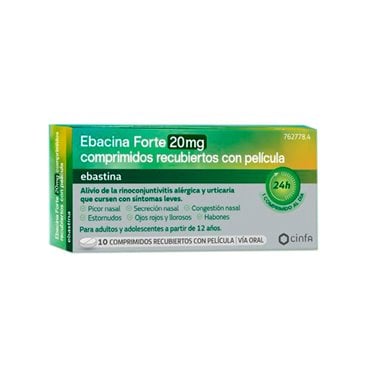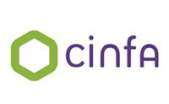Ebacina Forte 20 Mg 10 Coated Tablets
Ebastina is indicated for the relief of allergic rhinoconjunctivitis (sneezing, itchy nose, runny nose, nasal congestion and red, watery eyes) and urticaria (hives) that present with mild symptoms in adults and adolescents from 12 years of age, when the dose 10 mg is not enough.
Ebastina is indicated for the relief of allergic rhinoconjunctivitis (sneezing, itchy nose, runny nose, nasal congestion and red, watery eyes) and urticaria (hives) that present with mild symptoms in adults and adolescents from 12 years of age, when the dose 10 mg is not enough.
Ebacina Forte (20 Mg 10 Coated Tablets)
Ebastina
Action and Mechanism
- Antiallergic, histaminergic antagonist (H-1). Ebastine is a piperidine derivative that potently, competitively, reversible and specifically blocks H1 receptors, reducing the systemic effects of histamine in a prolonged manner. It results in vasoconstriction and decreased vascular permeability, reducing the redness and edema associated with allergy. Partially mitigates symptoms associated with allergic processes such as eye redness or nasal congestion. It also produces a slight bronchodilator effect and a decrease in skin itching. Clinical experience also seems to show that ebastine is capable of preventing the release of histamine from mast cells.
Ebastine is barely able to cross the blood-brain barrier, so it has virtually no significant sedative effects. It has great selectivity for H1 receptors, lacking significant anticholinergic and antiserotonergic effects. Likewise, no effects on the heart have been found in clinical trials, using doses of up to 100 mg.
Pharmacokinetics
- Absorption: Ebastine is rapidly absorbed in the intestine after oral administration, undergoing an intense hepatic first-pass effect that generates an active metabolite, carebastine. The Cmax of ebastine obtained after administering a dose of 20 mg is 2.8 ng/ml, while after administering a dose of 10 mg a Cmax of carebastine of 80-100 ng/ml is reached at 2.6-4 hours. Antihistamine activity begins after 1-3 hours, is maximum at 8-12 hours and can last up to 48 hours. After discontinuation of a 5-day treatment, antihistamine effects were seen for 72 hours, due to the metabolites of ebastine, mainly carebastine.
Effect of food : food increases the AUC of carebastin by 1.5-2 times, although this increase does not modify the Tmax. The administration of ebastine with food does not modify its clinical effect significantly.
- Distribution: Ebastine and carebastine are strongly bound to plasma proteins (95%).
- Metabolism: Ebastine is intensely metabolized by the CYP3A4 isoenzyme, giving rise to the active metabolite carebastine.
- Elimination: Ebastine is eliminated mainly by hepatic metabolism. 66% of the dose appears in urine, mainly in the form of conjugated metabolites. It may also appear in small amounts in feces (6%). The elimination half-life of carebastine is 15-19 hours.
Pharmacokinetics in special situations : no significant pharmacokinetic differences have been observed between patients over 65 years of age and young people, nor between individuals with different degrees of renal or hepatic insufficiency compared to healthy patients.
Indications - What is Ebacina Forte indicated for?
Dosage - How is Ebacina Forte taken?
"TABLET DOSAGE"
- Adults: 10-20 mg/24 h.
- Children and adolescents < 18 years:
* Adolescents from 12 years of age: no dosage adjustment required.
- Elderly: no dosage adjustment required.
Duration of treatment: until symptoms disappear.
Missed dose: Skip the missed dose and administer the next dose at the usual time. Do not double the next dose.
Polosogy in cases of kidney failure
It does not require dosage adjustment.
Polosogy in cases of liver failure
- Mild to moderate hepatic insufficiency (Child-Pugh class A): no dosage adjustment required.
- Severe hepatic insufficiency (Child-Pugh class C): maximum dose 10 mg/24 h.
Rules for correct administration
- Tablets: swallow whole, with the help of a glass of liquid, preferably water.
Administration with food : can be taken with or without food.
Advice to the patient
- It is recommended to administer this medication every day at the same time.
- The recommended dose should not be exceeded, as sedation could occur.
- It is advisable not to sunbathe during the treatment.
Contraindications
- Hypersensitivity to any component of the medication. There may be cross reactions with other antihistamines, so it is not recommended to use any H1 antihistamine in patients who have shown hypersensitivity to any compound in the group.
- Porphyria. H1 antihistamines have been associated with the appearance of porphyric outbreaks, so they are not considered safe in these patients.
Precautions
- Liver failure. Ebastine is extensively metabolized in the liver. In case of liver failure, an increase in plasma concentration may occur. It is recommended not to exceed the dose of 10 mg/24 hours in patients with severe hepatic insufficiency, while in those with mild or moderate insufficiency it is not necessary to take any action, although it is advisable to monitor these patients (See Dosage).
- Cardiac arrhythmia. Patients at cardiac risk, such as those with Bradycardia, prolongation of the QT interval, with Hypokalemia or under treatment with drugs that affect the QT interval or that inhibit the metabolism of ebastine (See Interactions). In clinical trials it has been proven that ebastine does not have significant effects on the heart at doses of up to 100 mg/24 hours, but this cannot be ruled out, so it is recommended to monitor cardiac function in these patients.
- Epilepsy. Caution should be exercised in epileptic patients, since antihistamines have sometimes been associated with paradoxical hyperexcitability reactions, even at therapeutic doses, which could lower the seizure threshold.
- Photosensitivity. Ebastine could give rise to photosensitivity phenomena, so it is recommended not to sunbathe during treatment, and to protect yourself with sunscreens.
- Acute allergic processes. Because ebastine can take around three hours to show pharmacological effects, its use is not recommended in severe acute allergic processes.
Precautions regarding excipients
- This medicine contains lactose. Patients with hereditary lactose or galactose intolerance, Lapp lactase insufficiency, or glucose or galactose malabsorption should not take this medication.
- This medicine contains fructose. Patients with fructose intolerance should not take this medication.
Special warnings
- Due to the anti-allergic effects of this medication, it could give false negatives in dermal tests for hypersensitivity to antigenic extracts. It is recommended to stop the administration of this medication at least 72 hours before the test.
- It is recommended to monitor cardiac function and the electrocardiogram in patients with heart disease or in those receiving ebastine together with erythromycin, ketoconazole or antiarrhythmic drugs, given the risk of prolongation of the QTc interval.
Interactions with other substances
No drug interactions have been observed with ebastine. The use of ebastine together with alcohol has not been shown to increase sedation. However, due to the risk of photosensitivity reactions due to the consumption of H1 antihistamines, ebastine could enhance the photosensitizing effects of other drugs.
- Erythromycin, ketoconazole. There have been some cases of slight prolongation of the QTc interval, of about 10 msec. It is unknown whether this effect is due to the enzymatic inhibition of CYP3A4 by macrolides or azole antifungals, or to the effects on the heart of these drugs. Extreme caution is recommended in patients receiving ebastine together with any of these drugs.
Pregnancy - Can I take Ebacina Forte during pregnancy?
Safety in animals: no direct or indirect harmful effects on reproduction in animals are observed.
Safety in pregnant women: no adequate and well-controlled studies have been conducted in humans. The use of this medication is only accepted in the absence of safer therapeutic alternatives.
Effects on fertility: no specific studies have been performed in humans. In animal studies, no fetotoxic or teratogenic effects of ebastine have been proven.
Breastfeeding - Can I take Ebacina Forte while breastfeeding?
Safety in animals: no data available.
Safety in humans: It is unknown whether ebastine is excreted in milk, but other antihistamines are. Both ebastine and its metabolite, carebastine, have a high degree of binding to plasma proteins (>97%), and this suggests that excretion does not occur in breast milk. However, it is recommended to stop breastfeeding or avoid the administration of this medication.
Children
Safety and efficacy have not been evaluated in children under 2 years of age, so it is recommended to avoid its use.
Doses of 10 and 20 mg are not indicated for children between 2-12 years of age, so it is recommended to use the oral solution in these children, adjusting the dose depending on age.
Advanced age
No specific problems have been described in elderly patients that require dosage readjustment. The pharmacokinetic profile of elderly and young people is very similar.
Effects on driving
Although in clinical trials ebastine has not given rise to sedation at doses of 30 mg/24 hours, post-marketing use has shown the appearance of cases of light sedation, so it is recommended to avoid driving dangerous machinery, including automobiles, until they have reasonable certainty that the pharmacological treatment does not adversely affect.
Adverse reactions
Overdose
Symptoms: There is little data on poisoning with ebastine. In a clinical trial in which a dose of up to 100 mg of ebastine was administered, no adverse reactions were observed.
Treatment: there is no specific antidote. Treatment will consist of the usual measures designed to promote the elimination of the drug. Symptomatic and supportive treatment is recommended, monitoring vital functions and the ECG.



